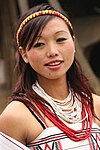Konyak Naga
Ethnically, culturally, and linguistically the Nocte and Tangsa of the same neighbouring state of Arunachal Pradesh, are also closely related to the Konyaks.[citation needed] The ethnic members maintain a very disciplined community life with strict adherence to duties and responsibilities assigned to each of them.[citation needed] Other unique traditional practices that set the Konyaks apart are gunsmithing, iron smelting, brasswork, and gunpowder making.A black residue floats on top of the water which is collected, dried, mixed with charcoal, and turned into gunpowder.[citation needed] The Konyak language belongs to the Northern Naga sub-branch of the Sal sub-family of Sino-Tibetan.


Naga woman
NagalandMyanmarNaga SAZKonyak languageBurmeseChristianityWanchoNaga Ethnic Groupsethnic groupNortheast IndianMon DistrictLongdingChanglangSibsagar DistrictNaga Self-Administered ZoneTangsadecapitationAoleangNorthern NagaSino-TibetanKonyakChingwang KonyakN. Bongkhao KonyakTobu constituencyPhangnon KonyakP. Paiwang KonyakNoke WangnaoW. WangyuhAngamiChakhesangChotheKharamKhiamniunganLainongLamkangLiangmaiMakuryMaringMonsangPochuryPoumaiRengmaRongmeiSangtamTangkhulThangalTikhirYimkhiungHill tribes of Northeast IndiaMizoramChakmaDimasa (Kachari)HajongKhasi and JaintiaSynteng or PnarLyngngamKuki TribesMan (Tai speaking)Mizo (Lushai) tribesMikir (Karbi)Naga tribesPawi (Lai)Synteng (Pnar)YimkhiungNagaBodo-KachariMeghalayaKhasi Synteng or PnarLakher (Mara)Arunachal PradeshAbor (Galo)Aka (Hruso)ApataniDafla (Nyishi)GalongKhowa (Bugun)MishmiMiju MishmiChugpaLishipaSherdukpenSingpho (Jingpo)Tai peoplesKhamptiKhamyangKhambaMinyongMishing (Miri)PuroikZekhringManipurGangteKoirao (Thangal)KoirengSuhte (Paite)ThadouVaipheiTripuraBhutiaJamatiaKhasiaLepchaLushai (Mizo)Munda, KaurNoatiaSantalTripuriSikkimSherpaTibetanHrangkhwal, RangkholKhelmaSairhem TangsaList of Scheduled Tribes in India